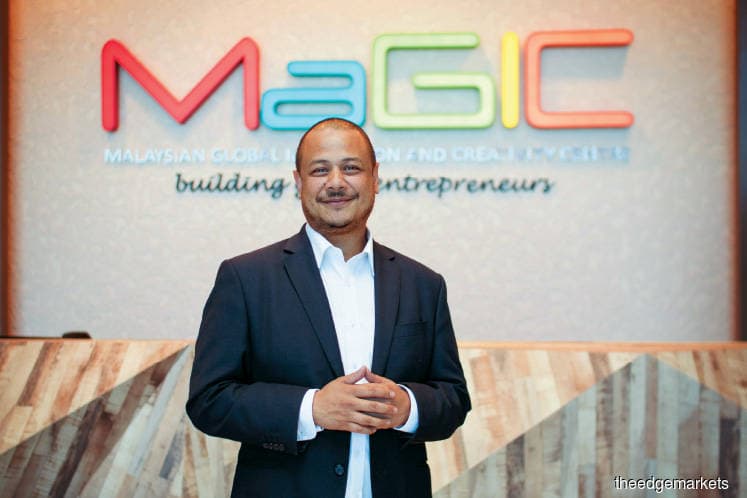
This article first appeared in Enterprise, The Edge Malaysia Weekly on January 8, 2018 - January 14, 2018
The Malaysian Global Innovation and Creativity Centre (MaGIC) has an extensive to-do list for 2018, chief among which will be to lay the foundation for a regulatory sandbox to facilitate the creation and commercialisation of start-ups in five key sectors: Smart Cities, Agrotech, Digital Health, Clean Energy and Mobility, CEO Ashran Ghazi tells Enterprise.
A regulatory sandbox is a framework that allows fintech start-ups and other innovators to conduct live experiments in a controlled environment under a regulator’s supervision.
Prime Minister Datuk Seri Najib Razak first mentioned a regulatory sandbox for these sectors during his Budget 2018 announcement, and Ashran now thinks the challenge will be to get the relevant relationships up and running before they begin to run test cases within the regulatory sandbox.
“I’m hopeful that we will be able to kick-start relationship-building for the sandbox as early as the first quarter of 2018. However, I could not say for certain exactly when we will be able to begin testing cases. It is important that we get the necessary relationships up and running first,” he says.
Ashran believes MaGIC is well-placed to spearhead the creation of this sandbox because over the past year, the organisation successfully drew pledges of cooperation from more than 40 corporates across a range of sectors. This, coupled with MaGIC’s extensive networks of local and foreign start-ups, means that the final — and arguably most challenging — piece of the puzzle will be to secure buy-in from a slew of highly influential regulators.
“In 2017, we saw interest among corporates to pursue corporate innovation exercises and, importantly, their willingness to work with start-ups and entrepreneurs to drive this innovation within their own companies and business units. To date, we have more than 40 corporates who want to innovate and look at new business models by collaborating with start-ups.
“The corporates we secured pledges from come from the property development, oil and gas, telecommunications, banking and insurance sectors.”
Ashran thinks 2018 and beyond will see the disruption of some highly regulated sectors. “We’ve already seen this happen to the likes of banking and insurance over the last few years, with a number of these companies having since pursued partnerships with various start-ups under Bank Negara Malaysia’s fintech regulatory sandbox, or even the corporates’ own venture funds or accelerators,” he says.
According to him, industries like healthcare and energy are also set to experience several disruptions, and it is important that all parties — traditional corporates, start-ups and regulators alike — operate from a position of openness and collaboration.
“We are still trying to refine our own approach to starting this sandbox. We want to ensure that regulators have sufficient visibility of the things that may affect their sectors, without necessarily stifling these changes.
“The fact is, we’re quickly moving out of the so-called ‘app economy’; the disruption is now going into healthcare, energy and transportation — sectors that are heavily regulated. And if we do not move for this regulatory sandbox right now, I fear that we’ll see another problem similar to what Grab and Uber had to contend with over the past few years, with the long-running dispute with the Land Public Transport Commission.”
Ashran’s hope is that MaGIC will be able to drive the regulatory sandbox in the five key sectors, working in concert with the various regulators as well as the start-ups and more established corporates. However, he does not believe MaGIC will play a role similar to Bank Negara’s in the fintech regulatory sandbox. “We intend to act as a facilitator between the various regulators in these five sectors and the corporates and start-ups. Ultimately, we do not want these highly valuable sectors to be bogged down by red tape,” he says.
Ashran points to one potential flashpoint that he hopes can be resolved within a regulatory sandbox. It is at this cutting edge of technology and business where the regulator’s buy-in and subsequent leeway becomes very important, he said on the sidelines of the Global Entrepreneurship Community Summit 2017 held from last month.
“In our booth at the exhibition area, there is a company known as Artnergy Sdn Bhd, which has pioneered floor panels capable of generating electricity. It is basically a solar layer that is also integrated into a system that converts kinetic energy — basically footsteps — into electrical energy. Can you imagine the power implications of fitting these ‘solar-kinetic’ panels into an outdoor walkway?
“Not only could you draw energy from both the sun and passers-by, a shopping mall or office building could use these tiles to acquire data on footfall.”
Save by subscribing to us for your print and/or digital copy.
P/S: The Edge is also available on Apple's AppStore and Androids' Google Play.